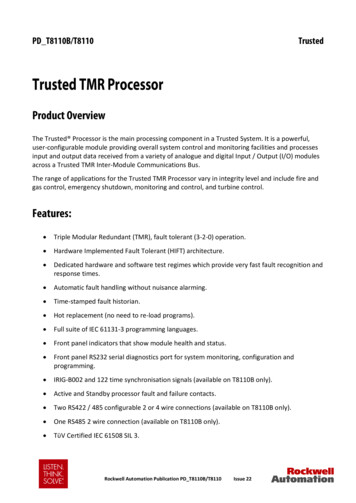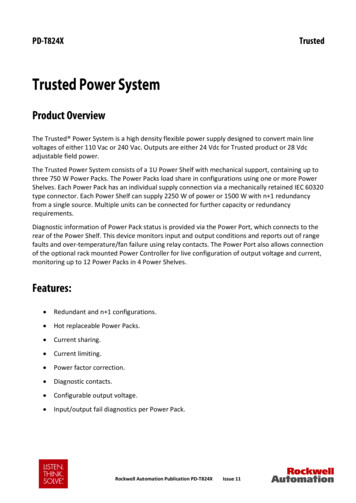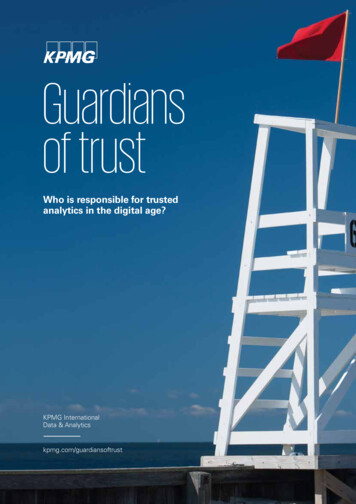
Transcription
Trusted Platform Module LibraryPart 1: ArchitectureFamily “2.0”Level 00 Revision 01.59November 8, 2019PublishedContact: admin@trustedcomputinggroup.orgTCG PublishedCopyright TCG 2006-2020TCG
Trusted Platform Module LibraryPart 1: ArchitectureLicenses and NoticesCopyright Licenses: Trusted Computing Group (TCG) grants to the user of the source code in this specification (the“Source Code”) a worldwide, irrevocable, nonexclusive, royalty free, copyright license toreproduce, create derivative works, distribute, display and perform the Source Code andderivative works thereof, and to grant others the rights granted herein. The TCG grants to the user of the other parts of the specification (other than the Source Code)the rights to reproduce, distribute, display, and perform the specification solely for the purpose ofdeveloping products based on such documents.Source Code Distribution Conditions: Redistributions of Source Code must retain the above copyright licenses, this list of conditionsand the following disclaimers. Redistributions in binary form must reproduce the above copyright licenses, this list of conditionsand the following disclaimers in the documentation and/or other materials provided with thedistribution.Disclaimers: THE COPYRIGHT LICENSES SET FORTH ABOVE DO NOT REPRESENT ANY FORM OFLICENSE OR WAIVER, EXPRESS OR IMPLIED, BY ESTOPPEL OR OTHERWISE, WITHRESPECT TO PATENT RIGHTS HELD BY TCG MEMBERS (OR OTHER THIRD PARTIES)THAT MAY BE NECESSARY TO IMPLEMENT THIS SPECIFICATION OR OTHERWISE.Contact TCG Administration (admin@trustedcomputinggroup.org) for information on specificationlicensing rights available through TCG membership agreements. THIS SPECIFICATION IS PROVIDED "AS IS" WITH NO EXPRESS OR IMPLIED WARRANTIESWHATSOEVER, INCLUDING ANY WARRANTY OF MERCHANTABILITY OR FITNESS FOR APARTICULAR PURPOSE, ACCURACY, COMPLETENESS, OR NONINFRINGEMENT OFINTELLECTUAL PROPERTY RIGHTS, OR ANY WARRANTY OTHERWISE ARISING OUT OFANY PROPOSAL, SPECIFICATION OR SAMPLE. Without limitation, TCG and its members and licensors disclaim all liability, including liability forinfringement of any proprietary rights, relating to use of information in this specification and to theimplementation of this specification, and TCG disclaims all liability for cost of procurement ofsubstitute goods or services, lost profits, loss of use, loss of data or any incidental, consequential,direct, indirect, or special damages, whether under contract, tort, warranty or otherwise, arising inany way out of use or reliance upon this specification or any information herein.Any marks and brands contained herein are the property of their respective owners.Page iiNovember 8, 2019TCG PublishedCopyright TCG 2006-2020Family “2.0”Level 00 Revision 01.59
Part 1: ArchitectureTrusted Platform Module LibraryChange HistoryRevision 98Added parameter to MemoryMove(), MemoryCopy(), and MemoryConcat() to make sure that the databeing moved will fix into the receiving bufferChange the size of local 2B buffers so that they are sized to the sum of the sizes of the elements ratherthan any other mathematical construct. This forces the size of the local buffer to track any changes to thesizes of the input components rather than have some assumed relationship.Made multiple changes to code to eliminate “dead” code (code that could not be reached by anyperturbation of the inputs).Removed the “ ” from the handle parameter in TPM2 HMAC Start().Changed TPM RC BAD TAG to 0x01e so that its value would match TPM BADTAG from 1.2Changed reference implementation so that it would only allow use of default exponent for creation of RSAkeys. It will allow other exponents for imported keys.Changed cpri GenerateKeyRSA() in CpriRSA.c so that it no longer reads outside the bounds of anarray when getting a value to use for encrypting/decrypting with a key, generated from a seed.Removed TPM NV INDEX entity name space.Authorization check includes locality.Revision 99Added phEnableNV to make NV enable independent of the platform hierarchy enable.Added TPM2 PolicyNvWritten to permit a policy based on whether or not NV has been writtenAdded TPM PT NV BUFFER MAX, the maximum data size in an NV write.Added define for HCRTM PCR, platform specificReturn code when an NV hierarchy is disabled is TPM RC HANDLE.TPM2 Shutdown state may be nullified on any subsequent command.CTR mode increments the entire IV, not just 32 bits.TPM2 PolicySecret cannot have a null authHandle.Revision 101Added Definitions for Endorsement Authorization, Owner Authorization, Platform Authorization.An error may change TPM state under certain conditions.A restricted signing key cannot have a scheme of TPM ALG NULL.Added TPMS EMPTY.Family “2.0”Level 00 Revision 01.59TCG PublishedCopyright TCG 2006-2020Page iiiNovember 8, 2019
Trusted Platform Module LibraryPart 1: ArchitectureTPM2 Sign: The signing scheme hash algorithm determines the size of the hash to be signed. However,this may be removed in a future revision.TPM2 PCR Allocate may return an error if the allocation fails.Revision 103Added ISO/IEC references and forward.Handle errors always return TPM RC HANDLE, not TPM RC HIERARCHY.TPM PCR Allocate does not change allocation for a bank not listed.For a policy ticket, if expiration is non-negative, a NULL ticket is returned.Revision 105Added lockoutPolicy.Added vendor-specific handles.Added detection of a clock discontinuity to tickets.Reworked TPM2 Import description.Revision 107Some reworking of H-CRTM, D-RTM.Some clarification of policy expiration.Changed references to ISO/IEC standards.Change PPS, EPS Clear flush resident transient and persistent objects.Revision 109Any field upgrade preserves state, not just the standard commands.Added TPM 2.0 Part 1 description of vendor-specific authorization values.Refined description of PCR interaction with H-CRTM, TPM2 Startup, and locality. TPM2 Hash Startindicates the start of an H-CRTM sequence, not DRTM.A non-authorization session must have at least one of encrypt, decrypt, or audit setA policy session timeout can only change to a shorter value.Added defines for ECC curves and removed some redundant values in the Part B annex.TPM2 Sign can use a symmetric key.TPM2 NV UndefineSpace fails if TPMA NV POLICY DELETE is set.Page ivNovember 8, 2019TCG PublishedCopyright TCG 2006-2020Family “2.0”Level 00 Revision 01.59
Part 1: ArchitectureTrusted Platform Module LibraryRevision 111TPM2 ContextSave encrypts just the TPM2B CONTEXT SENSITIVE structure.TPM 2.0 Part 2 structures removed algorithms and added notation referring to algorithm registry.HMAC commands cannot be used with a restricted key.Revision 113Clarified Auth Role for hierarchies and NV Index.Added password check to authorization checks.Indicated that handles returned by the TPM are TPM HT TRANSIENT (three places).Revision 115FIPS 186-4 note.Return codes for tag requires vs. actual mismatch.Revision 117A trial session cannot use encrypt or decryptHMAC is optional when the HMAC key is the Empty Buffer. If present, it must be correct.CFB uses sessionValue in the KDF, not sessionKeyFIPS-140 requires NV to be erased when an Index is deleted. NV data must be initialized on a first partialwrite.TPM2 Create for a keyed hash object must have TPM ALG NULL if sign and decrypt are both SET orCLEAR.For an unrestricted HMAC key, if both the key and parameter have a non-NULL scheme, they mustmatch.Revision 119Defined transient object and made the use of object and sequence object more consistent.Refined the description of an exclusive audit session, the definition of auditReset, and its relationship tothe audit attribute.Explained that the TPM clock must be accurate even if there is no reliable external clock.Updated the informative algorithm ID table.TPM2 HMAC and TPM2 HMAC Start return code change.All signing commands, including attestation commands, return TPM RC KEY for a non-signing key.TPM2 SetCommandCodeAuditStatus is not audited when used to change the algorithm.Family “2.0”Level 00 Revision 01.59TCG PublishedCopyright TCG 2006-2020Page vNovember 8, 2019
Trusted Platform Module LibraryPart 1: ArchitectureTrial policy sessions check authorizations.DA protection does apply to TPM RH LOCKOUT.Revision 121continueAuthSession is ignored for a password session.Reworked NV attributes to accommodate more NV types. Defined TPM NT.For a hybrid counter Index, the first write always writes through to NV memory.Added ECC point padding description.Unmarshaling routines return error code, not bool. Detailed CommandDispatcher parameters. Unmarshalflag set means null is permitted.The algorithm ID table in this specification is informative.Context gap must be 2 n-1.Handle type 0x03 is for saved sessions, not active session.Timeout is of length TPM2B DIGEST, not UINT64.nullProof can be used in a ticket.TPM2 EncryptDecrypt uses an unrestricted key. The sign attribute is used as an encrypt attribute. A nonnull mode cannot be overridden.A TPM2 PolicySecret being satisfied by a policy requires a password or auth value. The object mustpermit password or HMAC authorization.TPM2 PolicyNV is an immediate assertion.Revision 122NULL password can have continue set or clear.Sign attribute becomes encrypt attribute for a symmetric cipher object.Saved context metadata is normative. Encrypted data is vendor specific.TPMU SYM MODE, TPMS SCHEME XOR selector permits NULL.If the session requires a policy session, returns TPM RC AUTH TYPE.TPM2 NV Certify returns TPM RC NV UNINITIALIZED if unwritten even if size is zero.Revision 123Advised that callers should not use NV read public to calculate the Name.Removed advice that FIPS may require an authValue size of half the hash algorithm digest size.Page viNovember 8, 2019TCG PublishedCopyright TCG 2006-2020Family “2.0”Level 00 Revision 01.59
Part 1: ArchitectureTrusted Platform Module LibraryClarified that nonceTPM is only used once in an HMAC calculation when the session is being used forboth encrypt and decrypt.Clarified that authValue is an Empty Buffer if a session is not an authorization session.Clarified that sessionValue for authorization sessions that are encrypt or decrypt sessions is sessionKey authValue regardless of binding.Clarified that nameAlg is the authPolicy hash algorithm.Structure definition lower limits apply to TPM inputs. Upper limits refer to inputs and outputs.The year and day of year can indicate an errata date.TPM RC NONCE is returned for a nonce value mismatch.TPMS ALGORITHM DETAIL ECC kdf can be TPM ALG NULL.TPMS CONTEXT savedHandle indicates the context type.If a handle in handle area references a session and the session is not present, returnsTPM RC REFERENCE H0 N.Clarified that the size of an encrypted parameter can be zero.TPM2 Startup can result in the PCR update counter non-zero because of PCR resets.For RSA salt key, the size of an encrypted salt must be the same as the size of the public modulus.TPM2 ECDH KeyGen requires restricted CLEAR and decrypt SET.TPM2 Commit does not require the sign attribute.TPM PolicyOR extends the digest into a Zero Digest PolicyDigest. It does not replace the digest.TPM2 PolicyPCR with a trial policy may use the TPM PCR if the caller does provide PCR settings.TPM2 PolicyNV, TPM2 PolicyCounterTimer, TPM2 NV Certify, can return TPM RC VALUE if theoffset is greater than the data size.Indicated that the reference implementation can do compare operations on a structure using a cast to abyte array, so unmarshaling code must initialize input buffers.Revision 124This revision begins to implement the NV PIN Index type. The information is incomplete and subject tochange. It is included as a work in progress rather than create two forks to the specification.Clarified that TPM2B DATA is the size of a TPMT HA but is not required to contain an algorithm ID.Clarified that time can be set to zero at TPM Init or TPM2 Startup.TPM2 StartAuthSession rejects a symmetric salt key.Revision 125Family “2.0”Level 00 Revision 01.59TCG PublishedCopyright TCG 2006-2020Page viiNovember 8, 2019
Trusted Platform Module LibraryPart 1: ArchitectureContinued specifying NV PIN Index. The information is complete but not reviewed and still subject tosignificant changes.Session-based encryption should support XOR, but a block cipher is platform specific.Added TPM PT MODES for FIPS and other indications. Added TPMA MODES.Clarified the TPMA STARTUP CLEAR attribute (enable flags) settings on the various startup types.PRIVATEstructure - changed from TPMT SENSITIVE to TPM2B SENSITIVE.Revision 126Reworded the PIN Index and rewrap text.Added restrictions on unique input for TPM2 Create and TPM2 CreatePrimary.Removed obsoleteTPM CC PP FIRST and TPM CC PP LAST.Revision 127Removed symmetric salt.Revision 128sensitiveDataOrigin is set for an asymmetric object.Clarified that only the template unique field may be altered when an object is created.A PIN index can be used in TPM2 PolicySecret if read or write locked.ehProof is changed on TPM2 Clear.TPM2 SetPrimaryPolicy requires a policy length consistent with the hash algorithm.Revision 130Augmented section 27.1 “Object Creation / Introduction” by adding the table “Creation Commands” and adescription of that table.Augmented section 27.6.1 “Entropy Creation / Introduction” by adding the table “Deriving CryptographicValues” and a description of that table.Added TPM2 PolicyTemplate(), TPM2 CreateLoaded(), TPMI DH PARENT.Revision 131Added TPM2 PolicyAuthorizeNV(), TPM2 EncryptDecrypt2().Noted that TPM2 Create() may require transient resources.TPM2 Clear() increments the pcrUpdateCounter, permitting a policy that can be invalidated onTPM2 Clear().TPM PT NV BUFFER MAX returns the maximum size for NV read and NV certify as well as NV write,Page viiiNovember 8, 2019TCG PublishedCopyright TCG 2006-2020Family “2.0”Level 00 Revision 01.59
Part 1: ArchitectureTrusted Platform Module LibraryNoted that TPMA NV POLICY DELETE with a policy that cannot be satisfied defines an Index that cannever be deleted.TPM2 NV Read ignores offset for bits and counter indexes.Revision 132Reworked Part 4 for refactored crypto code merge.Added application note on audit alternative.Added command code for PolicyAuthorizeNV and EncryptDecrypt2.Added getcapability TPM CAP AUTH POLICIESTPMS TAGGED POLICY.forhierarchypolicies,andnewstructureOffset is ignored when reading counter and bits NV indexes.ReadClock can have audit session.Revision 133Added additional option to ticket expiration, and timeEpoch.TPM2B PRIVATE always has authorization value padded.Clarified GPIO inputs and outputs.EC Schnorr computation changes.Salt always uses OAEP.KDF must reject weak keys.Revision 134TPM2 Create for a fixedParent storage key only requires the symmetric algorithm of the parent and childto match.Policy ticket creation also digests the timeEpoch.Revision 135Weak symmetric keys will not be generated and cannot be loaded.OAEP uses the object's scheme. If the object's scheme is TPM ALG NULL, uses the objects Namealgorithm.GPIO input and output settings are platform or vendor specific.Added a TPM2 Create, etc. reference code error check if data objects have sensitiveDataOrigin SET.The normative text was correct.Revision 135 June 20Modified the ECDAA signature calculationFamily “2.0”Level 00 Revision 01.59TCG PublishedCopyright TCG 2006-2020Page ixNovember 8, 2019
Trusted Platform Module LibraryPart 1: ArchitectureRevision 136Added PolicyAuthorize definition.Noted that weak symmetric keys are not permitted.OAEP uses the key's scheme unless it is NULLModifications to the ECDAA sign operation.Parents use CFB mode, and cannot have a NULL symmetric algorithmThe salt key scheme must be NULL or OAEP.Revision 137Updated the interaction between nonceTPM and expiration.data may be a non - Empty Buffer when a primary key is created.TPM2 PolicySecret() referencing a PIN Pass Index returns a NULL ticket.TPM2 SelfTest returns TPM RC FAILURE on failure.phEnableNV is set on TPM Reset or TPM RestartTPM2 Create and TPM2 CreatePrimary input is actually TPM2 PUBLIC even though the parametersays TPM2 TEMPLATE.TPM2 PolicySecret for PIN and non-PIN Index clarifications.TPM2 PolicyNV, TPM2 NV Read, TPM2 NV Certify may ignore offset parameter.TPM2 NV GlobalWriteLock, TPM2 NV ReadLock may write NV.Part 4 added SelfTest.h, Simulator fp.h, removed CryptEccData.c,Part 4 updated TPM2B structure sample.Revision 138Added back expiration comment that timeout cannot become smaller.Explained the result of TPM CAP AUTH POLICIES.Removed obsolete CommandDispatcher.h and HandleProcess.h.Revision 139Revision 140Added Attached Component (AC Send) description, structures, and functions.TPM2 ECC Parameters() may zero pad results.TPM2 DictionaryAttackParameters does not reset failedTries.Page xNovember 8, 2019TCG PublishedCopyright TCG 2006-2020Family “2.0”Level 00 Revision 01.59
Part 1: ArchitectureTrusted Platform Module LibraryRevision 141Clarified that the KDFa 0x00 byte is only explicitly added if Label is not present or if it is not NULLterminated.Clarified that recoveryTIme may be tracked through a shutdown.Added TDES annex explaining parity generation.Revision 142Code merge with 141.Revision 143Clarified HMAC key calculation for bound policy session with and without TPM2 PolicyAuthValue. Similarclarification for encrypted policy session.Added the TPM2 MAC commandsTPMI ALG MAC SCHEME.andmergedwithTPM2 HMACcommands.AddedChanged TPM2B TIMEOUT back to a UINT64.TPM2 FlushContext for sessions ignores the upper byte of the handle.Revision 144Minor updates for TPM2 MAC.Added TPMI ALG CIPHER MODE, used for EncryptDecrypt.Salt key must be a decrypt key.seedValue is the size of the nameAlg digest.Revision 145More informative explanation. No normative changes.Revision 146Typos and fonts. No normative changesRevision 147Field upgrade should preserve the TPM vendor provisioned EKs.Salt can only use asymmetric key encryption.Alternative implementation of failedTries on non-orderly shutdown.Added description of entropy usage for derived objects.Alternate implementations for NV counter index initialization.TPM PT NV COUNTERS MAX - zero value indicates no specified maximum.Family “2.0”Level 00 Revision 01.59TCG PublishedCopyright TCG 2006-2020Page xiNovember 8, 2019
Trusted Platform Module LibraryAdded TPMI DH SAVEDTPM2 FlushContext.forPart 1: ArchitecturehandlevaluesthatcanbeusedinTPM2 ContextSaveorTPMS SCHEME XOR cannot have a NULL hash algorithmTPM2 PolicyTemplate() error codes if command is sent twice or if cpHash is already set.CryptSym.h added to Part 4.Revision 148Reworked the attestation key certification to indicate that an encrypted challenge response is a morelikely use case than an encrypted certificate.Field upgrade should not affect TPM2 CreatePrimary() outputs under certain conditions.The reset of the TIme circuit is related to TPM power, not TPM Init.MAX SYM DATA 128 changed from shall to should.sign and decrypt both CLEAR or SET and scheme not TPM ALG NULL returns TPM RC SCHEME.TPM2 PCR Allocate() takes effect at TPM Init(), not TPM2 Startup().Clarified in the text (the code was correct) that TPM2 PolicyDuplicationSelect() Names do not include thesize.The TPM may enter Failure mode if TPM2 Startup() is not TPM SU CLEAR after an algorithm setchange that affects PCR banks. It was previously not a may.After a field upgrade, preserving seeds, etc. was changed from shall to should.Revision 149Part 1 added phEnableNV to STATE CLEAR DATA, clearCount increments on TPM Restart, not TPMResumeNoted that TPM2 EventSequenceComplete() always returns all hashes.Noted that TPM2 PCR Allocate() requirement for TPM SU CLEAR only applies until after the nextTPM Init.Part 4: For code merge: Added KdfTestData.h. Deleted BnEccData.c. Changed CryptDataEcc.c toCryptEccData.cRevision 150Added some notes about the interaction between audit and parameter encryption. Clarified that the auditdigest is a single hash of cpHash and rpHash.The random commit value has to be at least equal to the security strength of the signing key. KDFa forthe commit calculation uses vendorAlg, not nameAlg. decoration only applies to command parameters, not response parameters.TPM2 Startup() does not clear the written bit for an orderly counter Index.Page xiiNovember 8, 2019TCG PublishedCopyright TCG 2006-2020Family “2.0”Level 00 Revision 01.59
Part 1: ArchitectureTrusted Platform Module LibraryRemoved CryptHashData.h.Revision 151TPM2 Hash() and TPM2 SequenceComplete() creates a ticket, with an Empty digest if in the NULLhierarchy.TPM2 VerifySignature() returns a ticket with an Empty digest if the key is in the NULL hierarchy.Updated ECC key generation and point padding in the Part 1 annex.The TPM PT PS REVISION value is platform specific.Moved implementation specific description of the Clock Safe flag to an example.Clarified that the getcapability returning TPML PCR SELECTION must return a selection for allocatedbanks but can return additional selections.Revision 152Added a first draft of TPM2 CertifyX509().Revision 153C.5 ECC Key Generation changed d to c and G to Q.TPM2B PRIVATE KEY RSA is permitted to be larger for fixedTPM keys. the TPM2B PRIVATEstructure in TPM2 Create() and TPM2 Load() may contain five CRT primes (instead of one).Assign TPM CC CertifyX509 command code, x509Sign attribute, TPMA X509 KEY USAGE, AddTPM2 CertifyX509 description, parameters, and actions.Define NV digest attestation structure, TPMS NV DIGEST CERTIFY INFO, and added certifying an NVdigest to TPM2 NV Certify.Revision 154Clarify that label in KDFa is an octet stream and the conditions for the KDFa zero byte.Clarify the required size of an object sensitive area seedValue for TPM generated and imported objects.Clarify that the L parameter in OAEP is a byte stream with the last byte zero, not a null terminated string.Add an Annex with a Library Profile Guide.Clarify that TPM PT NV BUFFER MAX applies to NV extend or NV certify.The TPMA X509 KEY USAGE keyAgreeement and encipherOnly attributes require the decryptattribute.Explain that most of TPM2 SetAlgorithmSet is vendor-dependent.Explain that the initialization of the list of commands requiring physical presence is platform-specific.Revision 155Family “2.0”Level 00 Revision 01.59TCG PublishedCopyright TCG 2006-2020Page xiiiNovember 8, 2019
Trusted Platform Module LibraryPart 1: ArchitecturePart 2 removed , S AND IO from several table titles.TPM ECC CURVE add to TPM ECC NONEPart 4 added files for X.509 support: OIDS.h, MinMax.h, and AC support: AC spt.cChanged Implementation.h to TpmProfile.h and added a pointer in TpmBuildSwitches.h to preset thevalues.Revision 156Added the ACT feature.Explained that the TPM2 CertifyX509 partialCertificate and addedToCertificate are a DER encodedSEQUENCEs. Explained the encoding of the TPMA OBJECT element. Noted that tbsDigest is returnedas a debugging aid. Changed qualifyingData to reserved and that it must be an Empty Buffer.Added a requirement that, if a command resets PCR in multiple banks, the PCR Update Counter must beincremented only once. If a command causes PCR in multiple banks to change, the PCR Update Countermust be incremented once for each bank.Revision 157Added the ACT code.Revision 158Minor updates to the ACT description.Revision 159Added several missing source code files to Part 4.Reversed the TPMA X509 KEY USAGE bit map.Page xivNovember 8, 2019TCG PublishedCopyright TCG 2006-2020Family “2.0”Level 00 Revision 01.59
Part 1: ArchitectureTrusted Platform Module LibraryAcknowledgementsThe writing of a specification, particularly a security specification, takes many hours for both developmentand review. This specification is no exception with roughly 100 individuals involved in the process. TheTCG would like to acknowledge the contribution of those individuals (listed below) and the companieswho allowed them to volunteer their time to the development of this specification.The TCG would like to acknowledge the special contribution of David Wooten in the development of theTPM 2.0 architecture and documentation of this specification. We also acknowledge the generosity ofMicrosoft in contributing the code in this specification, written by David Wooten, Jiajing Zhu, and PaulEngland.Special thanks are due to David Challener, David Wooten, Julian Hammersley, Graeme Proudler, and AriSinger who served as Chair of the TPM Working Group at different times during the development of thisspecification.The TCG would also like to give special thanks to David Grawrock, David Wooten, and Ken Goldman,who were the editors of this specification.Family “2.0”Level 00 Revision 01.59TCG PublishedCopyright TCG 2006-2020Page xvNovember 8, 2019
Trusted Platform Module LibraryPart 1: ArchitectureContributors:Loic Duflot; ANSSIFrederic Guihery; AMOSSYSRalf Findeisen; AMDJulian Hammersley; AMDDean Liberty; AMDRon Perez; AMDEmily Ratliff; AMDGary Simpson; AMDGongyuan Zhuang; AMDJohn Mersh; ARM Ltd.Kerry Maletsky; AtmelRandy Mummert; AtmelRonnie Thomas; AtmelDouglas Allen; BroadcomChares Qi; BroadcomDaniel Nowack; BSIFlorian Samson; BSIBill Lattin; CerticomMatt Harvey; CESGPaul Waller; CESGBob Bell; CiscoBill Jacobs; CiscoRafael Montalvo; CiscoFrank Mosberry; DellAmy Nelson; DellAri Singer; DMISigrid Gürgens; Fraunhofer SITAndreas Fuchs: Fraunhofer SITCarsten Rudolph; Fraunhofer SITCarline Covey; Freescale SemiconductorIra McDonald; High NorthVali Ali; Hewlett PackardLiqun Chen; Hewlett PackardCarey Huscroft; Hewlett PackardWael Ibrahim; Hewlett PackardGraeme Proudler; Hewlett PackardKen Goldman; IBMHans Brandl; InfineonHubert Braunwarth; InfineonGa-Wai Chin; InfineonRoland Ebrecht; InfineonMarkus Gueller; InfineonRalph Hamm; InfineonGeorg Rankl; InfineonWill Arthur; IntelErnie Brickell; IntelAlex Eydelberg; IntelDavid Grawrock; IntelJiangtao Li; IntelDavid Riss; IntelNed Smith; IntelClaire Vishik; IntelMonty Wiseman; IntelIgor Slutsker; IntelLiran Perez; IntelZecharye Galitzky; IntelJoshua Su; ITEDavid Challener; Johns Hopkins APLPage xviNovember 8, 2019Huang Qian; LenovoRonald Aigner; MicrosoftJing De Jong-Chen; MicrosoftShon Eizenhoefer; MicrosoftCarl Ellison; MicrosoftPaul England; MicrosoftLeonard Janke; MicrosoftRichard Korry; MicrosoftJork Loeser; MicrosoftAndrey Marochko; MicrosoftJim Morgan; MicrosoftDennis Mattoon; MicrosoftHimanshu Raj; MicrosoftDavid Robinson; MicrosoftRob Spiger; MicrosoftStefan Thom; MicrosoftMark Williams; MicrosoftDavid Wooten; MicrosoftJiajing Zhu; MicrosoftLuis Samenta; MITAriel Segall; MITRENataly Kremer; M-Systems FlashAndrew Regenscheid; NISTQin Fan; NationzJay Liang; NationzXin Liu; NationzJan-Erik Ekberg; NokiaMichael Cox; NTRUNick Howgrave-Graham; NTRUWilliam Whyte; NTRULeooid Asriel; NuvotonDan Morav; NuvotonErez Naory; NuvotonOren Tanami; NuvotonDennis Huage; NVIDIAWhllys Ingersoll; OracleScott Rotondo; OracleTimothy Markey; PhoenixAnders Rundgren; PrimeKey SolutionsLaszlo Elteto; SafenetMichael Willet; SeagateOlivier Collart; STMicroelectronicsMiroslav Dusek; STMicroelectronicsJan Smrcek; STMicroelectronicsMohamed Tabet; STMicroelectronicsPaul Sangster; SymantecJerome Quevremont; ThalesMark Ryan; University of BirminghamMike Boyle; US Department of DefenseStanley Potter; US Department of DefenseSandi Roddy; US Department of DefenseAdrian Stanger; US Department of DefenseKelvin Li; VIANick Bone; VodafoneMihran Dars; Wave SystemsThomas Hardjono; Wave SystemsGreg Kazmierczak; Wave SystemsLen Veil; Wave SystemsTCG PublishedCopyright TCG 2006-2020Family “2.0”Level 00 Revision 01.59
Part 1: ArchitectureTrusted Platform Module LibraryCONTENTSScope . 1Specification Organization. 2Normative references . 3Terms and definitions . 4Symbols and Abbreviated Terms . 145.15.2Symbols . 14Abbreviations . 14Compliance . 17Conventions . 187.17.27.3Bit and Octet Numbering and Order . 18Sized Buffer References . 18Numbers . 18Changes from Previous Versions . 20Trusted Platforms . 219.19.2Trust . 21Trust Concepts.
Trusted Platform Module Library Part 1: Architecture TCG . 2
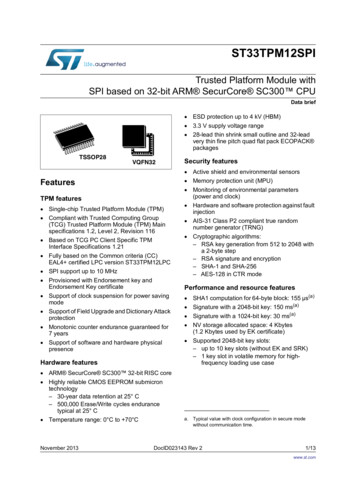
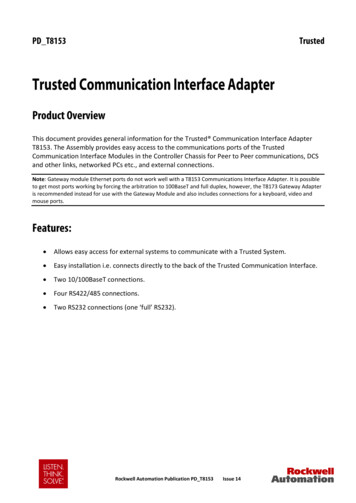
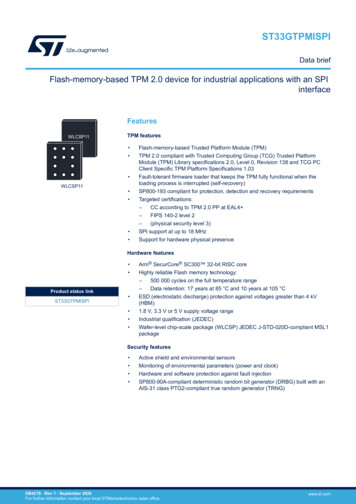
![[MS-TPMVSC]: Trusted Platform Module (TPM) Virtual Smart Card .](/img/62/5bms-tpmvsc-5d-210407.jpg)
